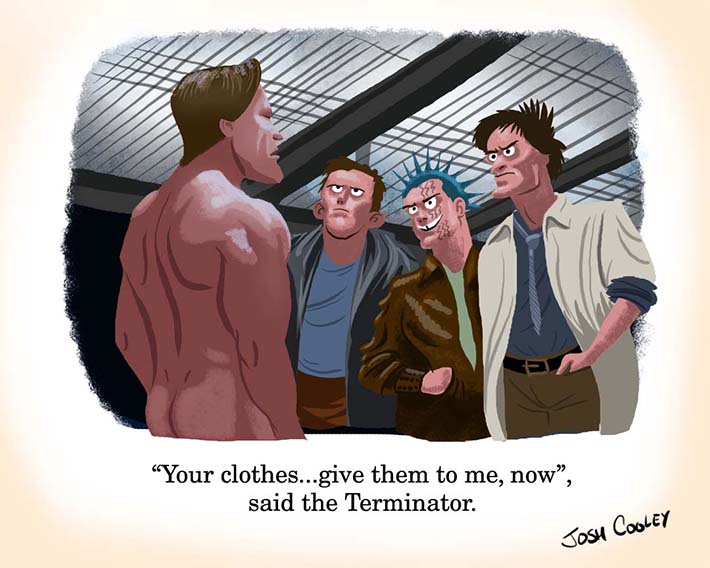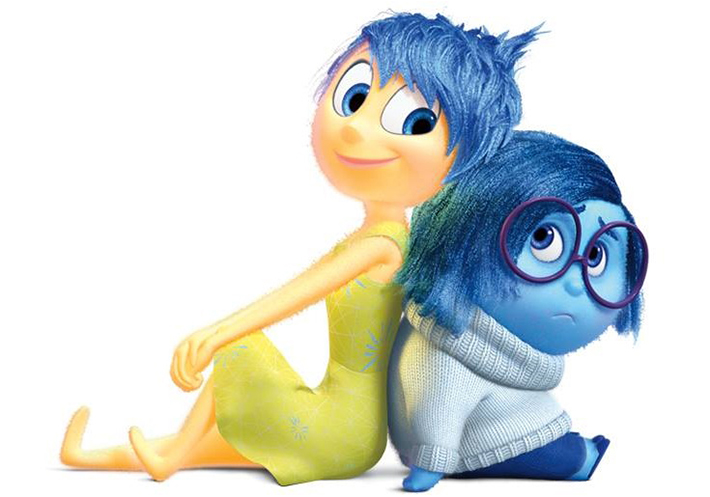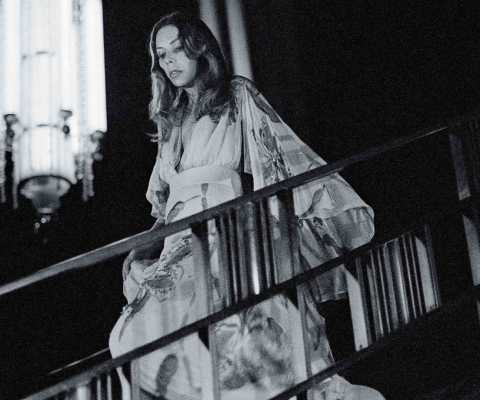For the second part of our Inside Out interview series, we talked to co-writer Josh Cooley. Cooley began as an intern in the storyboard department for Cars and has worked in varying capacities on almost every Pixar feature since. As a story artist, he’s worked his way up the ranks and was the head of the story department for Inside Out, an assignment that ultimately ended up getting Cooley his first feature film screenwriting credit.
Cooley made a splash online when his ‘Movies R Fun‘ images depicting iconic movie scenes as if they were drawn for children went viral and were later compiled in a book. He was named one of Variety’s Top Ten Animators to watch, but this was after it was announced that he’d be co-directing Toy Story 4 with John Lasseter, so he’s not exactly an ‘up and comer’. With these recent achievements, Cooley has truly arrived and he’ll be sharing some of what he’s learned along the way in the form of a six-hour masterclass presented by Toronto Animation Arts Festival International this weekend.
How long has Inside Out been dominating your life for now?
Definitely over four years… four and a bit. It’s longer than I was in High School. It’s a little surreal to see billboards and advertisements for things we came up with three years ago. It’s finally out there.
Where did you go to school?
I’m from the Bay area. I grew up in Livermore which is about 30 miles east of San Francisco. I’m very local to where Pixar is. I went to art school in San Francisco and then was hired at Pixar so I never had any reason to leave the Bay area.
So I guess pursuing animation as a career wasn’t that far fetched…
It was when I was growing up because Pixar wasn’t here. I wanted to work for Disney and they were in L.A. or Florida so I never thought I’d be staying in the Bay area.
Were you a “Disney Kid”?
Yeah definitely. I was obsessed with the classic films, I just watched them constantly. I was really excited whenever a new Disney movie came out. I went to school to be a 2D animator so I was sure that was exactly what I was going to be doing. It didn’t exactly work out that way but that’s fine.
Do you remember the first time you watched Toy Story?
Yeah I do. I saw in the theatre with my brother and I was blown away but at the same time I was thinking, “ah this computer thing is just a phase.” (laughs) I was so into 2D animation that I never thought that this would be a path that I would go on.
How old were you?
I was still in High School, but from a really young age I knew I wanted to work in animation so that was always a goal of mine. My parents supported it so there was never a thought in my mind that I wouldn’t be doing this just because I was so supported by my artistic parents.
And the animating led to the writing?
I was always writing stuff, I never thought of it as being part of the job. What happened was I was in school to be a 2D animator and took a story class and I really fell in love with that because drawing was a part of it but it was also coming up with the ideas of what you were drawing. I never really thought of that as a path before but once I took that class I really fell in love with the idea so I decided to pursue that. As an intern you can contribute gags and ideas but it wasn’t actually sitting down and writing script pages, even as a story artist you do very little of that. Once I started working closely with Pete on Inside Out, he would come to me and ask ‘well what do you think this scene should be about?’ We’d riff and come up with ideas and he’d go “you know what this should be, why don’t you write it?” That was the first time I’d actually sat down with final draft and wrote out pages that were gonna be created and I love it, it’s really fun. It’s really hard, being terrified of the blank page, but I love it.
It seems like such a free flowing exchange of ideas at Pixar, does this ever complicate things when it comes to designating titles or credits?
The credit thing is not figured here, that’s figured out by a third party. I’m not really exactly sure how it works even. I didn’t even think about that, I was actually surprised that I got a writing credit because that was not what I set out to do, but I’m glad I did.
What were you initially brought on to do on Inside Out?
I was brought on as the head of story on this one, so I was the story supervisor leading the story team and as we were going along Pete would just keep saying why don’t you write this? Why don’t you write that? I was writing as well as storyboarding on the side and leading the team.
It sounds like most Pixar film productions have an ‘oh crap’ moment late in the process where you need to go back and rework major elements, was there anything like that on Inside Out?
Not late in the game. There’s always changes happening all the time, it’s never not changing. It’s a very fluid process. I can think of moments where we had big shifts in the direction of the story, but it wasn’t like a freakout moment, it helped and made the story stronger, that’s one reason to have them. In the movie Joy goes on this journey with Sadness, we had another version where she was on the journey with Fear. We tried that for a while and it didn’t really pan out. One of the major shifts that kind of put everything in line was Pete came back after a short vacation and said I think it should go back to being Joy and Sadness on this journey, and we thought about how Joy could learn about Sadness. Once we got in line with that everything started to click a little better. So there wasn’t any major freakout moment, or maybe I’m just suppressing that memory. (laughs)
Yeah, it seems that once Riley loses the ability to experience Joy, the instinct would be to have Sadness take over, but by having her loose both, we kind of learn that Joy and Sadness don’t have to be mutually exclusive, there’s merit in both.
Exactly yeah, that’s it. We just wanted Joy to learn that there is a benefit to Sadness and the only way we could do that was by putting them together. We couldn’t have Joy go on this journey through act two by herself, without having Sadness there. You stick two characters together who need to learn a lesson and then you can enforce that lesson throughout the movie.
I know you were considering more than just five emotions at one point, I can only imagine how Jealousy felt when it didn’t make the cut and the others did…
We did a lot of research talking to neurologists and this doctor, Dr. Keltner, who is a leading expert on emotions and what they do. Different neurologists say there are different numbers of emotions. Some say 27, others say there are 5, others argue there are 6, other say there are 3. We had version where we had 27 emotions in headquarters and as you can imagine it got messy really quickly. We had Jung, Freud and Jealousy and Surprise. It was too much so for story purposes we just made it down to the core 5.
Can you briefly tell us what are some lesson you took away from working on the story for Inside Out, or is the answer to that the 6 hour lecture you’re giving this weekend?
Yeah, there’s a lecture coming up about that, which I’ll get into it in depth. The thing that was the most challenging for this movie was that we basically had two stories happening at the same time, I’ve never worked on a movie that had that happen. You have what’s going on with Riley in her real world and what’s going on with her emotions in her mind world, we learned very quickly those stories have to interact with each other and they effect one another. Once Joy and Sadness got kicked out of headquarters, that’s almost like a third story happening. All those three things have to intertwine and that’s really challenging.
What else can people look forward to from your masterclass?
I’m really excited about it. I’m going to talk more in depth on what we’re talking about now, how we came up with the story for Inside Out. I’ve learned a lot from all the movies I’ve worked on here over the last 12 years, from all the different directors. I’m going to go over things that I think about that help me when I’m stuck working on stories and things that are tools to use to find the story you’re trying to tell.
Congratulations on getting the co-directing gig on Toy Story 4, what was it like finding out you’d be working side by side with the boss (Pixar Chief Creative Officer John Lasseter)?
That was crazy. I started as an intern here and was working with John as an intern and I’ve worked with him on other features. I love working with him, he’s the greatest director. He knows how to tap into that emotion and into the entrainment. He’s a pioneer of computer animation so to be able to be right alongside him and watching him work firsthand is just an honor. I also directed the short that will be on the Inside Out blu ray, but this will be my first co-directing gig on a feature.
What’s on your Dork Shelf?
I’m looking at it right now, as you say that. I’ve got shelves full of books, at work and at home, and just toys all over the place. Everything: Lego, Ghostbusters, Iron Giant, Toy Story, Inside Out, Futurama, Pinocchio, Planet of the Apes… just everything that I grew up with.
Read our interview with Inside Out story artist Domee Shi here.







Comments